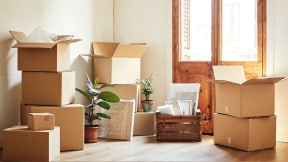Chicago neighborhood guide

Quick insights
- According to the Chicago Metropolitan Agency for Planning, Chicago has over 77 neighborhoods including Bronzeville, Lincoln Park and Pilsen, just to name a few.ftn-1 Each neighborhood represents a diverse array of people, cultural offerings and unique charm.
- There are many benefits of living in a Chicago neighborhood such as access to top-employers, quality schools and top-notch entertainment.
- Chicago’s cultural diversity can create an environment for young professionals, couples and families to connect with people from all walks of life.
Introduction to Chicago neighborhoods
Chicago is a captivating city with stunning architecture, ample job opportunities and expansive culinary delights. Each neighborhood has its own distinctive community dynamics, rich culture and unique characteristics.
With so many different towns and neighborhoods, deciding on a place to call home can be both exciting and overwhelming. It’s important to visit different neighborhoods and get a feel for the area when buying a home. In this guide, we will give you the home buying resources you need to make a decision. Here are a few questions to consider:
- Do you want to live in a highly walkable part of the city surrounded by iconic attractions and lively entertainment venues? Consider the Loop, West Loop, Streeterville or River North.
- Are you looking to live in a bigger home with a large backyard for your kids to play in, take a stroll along 31st Street Beach and get more value for your money? Consider Bronzeville, Hyde Park, Beverly or Rogers Park on the north side.
- Perhaps you want to live in a lakeside neighborhood with nice curb appeal, bustling retail shops, great schools and family-friendly activities? Consider Lincoln Park, Lakeview, Edgewater or Lincoln Square.
Number of neighborhoods in the city of Chicago
Some people may consider Chicago to be a “city of neighborhoods.” Chicago has approximately 77 officially recognized neighborhoods or community areas that represent a beautiful array of diverse cultures and people. You can visit historic communities and discover hidden architectural gems in Kenwood or admire tropical plants at the Garfield Park Conservatory, one of largest botanical conservatories in the nation. Each downtown neighborhood pays homage to Chicago’s landmarks, history, charming parks and chic urban finds.
Chicago is divided into four geographic sections: North Side, West Side, South Side and Downtown. The “Loop” is the main section of downtown Chicago. Each section of Chicago offers a unique blend of natural beauty, a sense of belonging and urban energy. You can grab a bike and ride along the Bloomingdale Trail (The 606), immerse yourself in the vast collection of fine art at the Art Institute of Chicago or visit an authentic taqueria-style Mexican restaurant in Little Village or Pilsen. Use this guide as a starting point and conduct additional research to find a location that suits your personal preferences and lifestyle.
Largest neighborhoods in the city of Chicago
According to the Chicago Metropolitan Agency for Planning, the largest neighborhoods in Chicago are Austin, Lakeview, Lincoln Park, Logan Square and Near North Side.ftn-1
- Austin: Located on the West Side of Chicago, Austin is one of the largest neighborhoods in the city. According to the Chicago Metropolitan Agency for Planning, the population in Austin is over 96,000.ftn-2
- Austin features historic architecture, beautiful parks, Austin Town Hall Park and easy access to public transit. Austin is approximately 8 miles from downtown Chicago Loop.
- Lakeview: Located in the city’s North Side with an alluring stretch of the Lake Michigan shoreline, Lakeview is an incredibly vibrant neighborhood. According to the Chicago Health Atlas, the population in Lakeview is over 100,000.ftn-3 You can cheer on the Chicago Cubs (MLB) at Wrigley Field or visit Montrose Beach with your furry companion. Lakeview is approximately 5 miles from downtown Chicago Loop.
- Lincoln Park: Located on the North Side of Chicago and home to Chicago’s largest public park is Lincoln Park. According to the Chicago Metropolitan Agency for Planning, the population in Lincoln Park is over 70,000.ftn-4 Lincoln Park is a tight-knit neighborhood great for a variety of ages and lifestyles. You can go for a nature walk at South Pond or get nose to nose with animals at Lincoln Park Zoo. Lincoln Park is approximately 3 miles from downtown Chicago Loop.
- Logan Square: Located on the Northwest side of Chicago’s Loop, Logan Square is a diverse community. According to the Chicago Metropolitan Agency for Planning, the population in Logan Square is over 71,000.ftn-5 This community is full of rich culture, locally owned shops and numerous amenities right at your doorstep. Logan Square is approximately 6 miles from downtown Chicago Loop.
- Near North Side: Stretching from just outside of downtown Chicago and home to iconic skyscrapers like the John Hancock Building is the Near North Side. According to the Chicago Metropolitan Agency for Planning, the population in the Near North Side is over 105,000.ftn-6 This area reflects Chicago’s bustling metropolitan atmosphere and includes neighborhoods such as Gold Cast, Old Town and River North. The Near North Side is an entertainment hub full of shopping districts, health stores, trendy bars and an eclectic community.
Downtown Chicago neighborhoods
Chicago is where Midwestern charm meets fast-paced, sophisticated city life. The downtown Chicago Loop area is the central business district of the city with new businesses, restaurants and opportunities popping up all the time. The neighborhoods of downtown Chicago are divided into the North, South and West side. From the trendy boutiques and thriving social scenes of River North to the rich intellectual history and gorgeous family parks of Hyde Park, there is a neighborhood to suit your lifestyle and specific tastes.
Depending on the stage you are at in life, you may have different priorities and unique needs. For instance, a major consideration for families choosing a place to live is a good education for their children. There are plenty of public and private schooling options for families with young children or couples planning to start a family. According to the Private School Review, as of 2024, there are 370 private schools and 654 public schools in Chicago.ftn-7
Chicago has an expansive healthcare system. According to Cause IQ, there are 110 hospitals and primary care medical facilities in the greater Chicago area including the city of Chicago and neighboring suburbs.ftn-8 Multiple world-renowned hospitals operate in Chicago including the massive Northwestern Memorial Hospital and Rush University Medical Center.
Surrounding neighborhoods of downtown Chicago
From South Loop to West Loop and many areas in between, the surrounding neighborhoods that encompass the downtown Chicago area offer unique characteristics and attractions. Each area is growing at a steady or rapid rate with strong signs of growth and new construction of homes. New construction and development in downtown areas closer to the Loop typically include high-end condos and townhomes.
The surrounding areas on the North, South and West side are prime locations because of their proximity to downtown Chicago and ample transportation options. Proximity to downtown Chicago typically means easier access to employee office, cultural attractions, shopping districts and entertainment. Many surrounding neighborhoods of downtown Chicago have excellent public transit options, including CTA buses, L trains and the Metra commuter rail system.
Popular attractions in Chicago neighborhoods
Chicago neighborhoods have distinct personalities and attractions that offer residents and visitors a great experience shaped by its culture, history and culinary scene. Here are some of the most popular attractions in Chicago neighborhoods.
- The Loop: You can catch spectacular views of the city from the Skydeck Chicago – Willis Tower, come face to face and touch a Beluga Whale at Shedd Aquarium, explore the city on the new flying attraction “Flyover Chicago” at Navy Pier, have a family picnic at Millennium Park and much more.
- West Loop: Passionate sports fans can cheer on the Chicago Bulls (NBA) and Chicago Blackhawks (NHL) at the United Center and grab a bite to eat at Randolph Street’s “Restaurant Row” after the game.
- Lincoln Park: Explore the beautiful oasis of Lincoln Park Zoo with your family or check out interactive exhibits and the butterfly haven at Peggy Notebaert Nature Museum. If you’re looking for thrilling aerial stunts and water demonstrations, carve out some time to attend the annual Chicago Air and Water Show every August.
- Hyde Park: The Museum of Science and Industry is full of amazing exhibitions such as The Blue Paradox and Black Creativity: Architecture. For art lovers, you may want to stop by the 57th Street Art Fair which showcases over 200 artists. Music enthusiasts can listen to live music at the Hyde Park Jazz Festival. After a busy day, you can eat some delectable soul food at Virtue Restaurant. Once fully opened, you can visit The Obama Presidential Center, a world-class museum, library and public gathering space.
- Bronzeville: Looking to visit a community that showcases a strong sense of pride in its cultural heritage and influential history? Visit the DuSable Museum of African American History. You can also attend the annual back-to-school Bud Billiken Parade to celebrate joy, togetherness, culture and education.
- Lakeview: We can’t mention Lakeview without talking about Wrigley Field, home to the Chicago Cubs and one of the oldest baseball stadiums in the country. After attending an exhilarating baseball game, check out the Belmont Theater District to see an array of performances, from Broadway shows to live music to improv comedy.
Additional information for first-time homebuyers
There are crucial factors to consider when choosing a neighborhood such as proximity to work, schools, work-life balance, transportation, grocery stores and availability of essential services. Gaining a greater understanding of the local real estate market and specific neighborhoods can help you narrow down your options, determine neighborhood suitability and potentially negotiate better deals.
You can explore various neighborhoods and use different resources to help inform your decision such as speaking to longtime residents, attending a community meeting or connecting with a real estate agent and local mortgage lender. Take the time to visit the neighborhoods during the daytime and nighttime to get a full portrait of the neighborhood's community, character and overall atmosphere.
Conclusion
As a first-time homebuyer, it’s critical to research different neighborhoods to give you greater insight into the local amenities, community engagement and proximity to work. The Chicago neighborhood in which you decide to purchase a home plays a major role in the overall homebuying experience and your quality of life. By focusing on careful planning, patience and due diligence, first-time homebuyers can navigate the process with more confidence. Contact a Home Lending Advisor for more information on how to get started.



